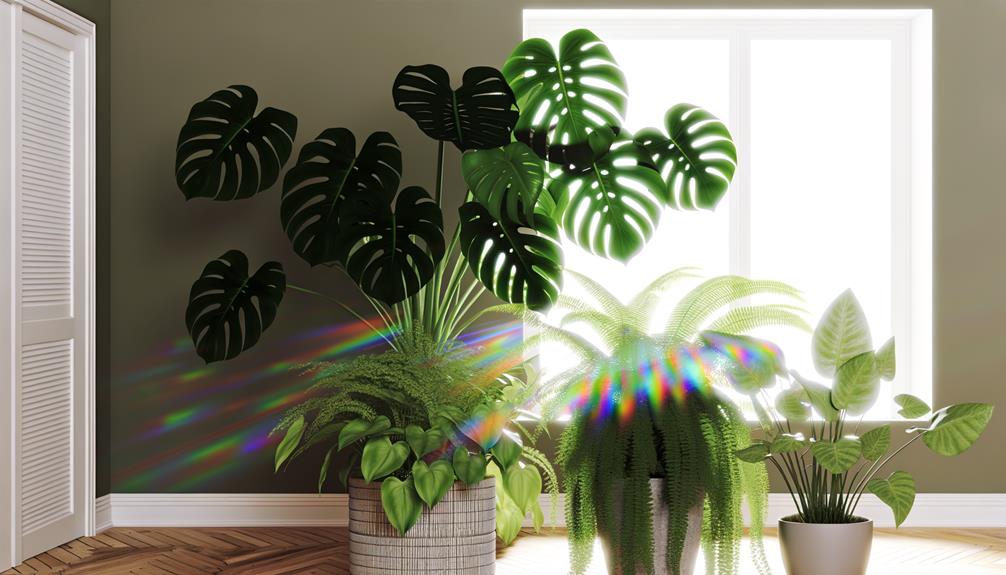Can I Plant Other Plants in the Same Pot With Monstera Deliciosa?
Yes, you can plant other species with your Monstera deliciosa, but you need to make sure they share similar environmental needs. Monstera thrives in bright, indirect light and needs a well-draining, organic-rich soil.
Companion plants should have comparable light and soil preferences, such as philodendrons or pothos. Check that the soil’s pH and water retention meet all plants’ demands to prevent nutrient competition.
Regularly monitor soil moisture and only water when the top two inches are dry. These steps guarantee harmonious growth and stress-free coexistence.
Keep exploring to discover the best companion plants and arrangement tips for your Monstera.

Key Takeaways
- Ensure companion plants share Monstera’s light and humidity requirements for optimal growth.
- Use a well-draining, organic-rich soil mix compatible with all chosen plants.
- Maintain a cohesive watering schedule to prevent over- or under-watering.
- Select plants with similar pH preferences to avoid nutrient competition.
- Ensure adequate root space to prevent overcrowding and stress on plants.
Compatibility Factors
When considering compatibility factors, it’s crucial to evaluate the light, humidity, and soil requirements of Monstera deliciosa and its potential companion plants to ensure harmonious growth.
Monstera deliciosa thrives in well-draining, organic-rich soil with moderate to high humidity levels. It’s essential that companion plants share similar preferences to guarantee they coexist without stress.
For instance, select plants that thrive in a slightly acidic to neutral pH range, typically between 5.5 and 7. Additionally, both Monstera and its companions should be able to tolerate occasional droughts without significant detriment. Incompatible plants may suffer from nutrient competition or divergent watering needs, leading to suboptimal growth.
Ideal Light Conditions
Monstera deliciosa, along with its companion plants, thrives best in bright, indirect light, ensuring strong photosynthesis and preventing leaf scorch.
You’ll want to place your pot near a north or east-facing window where it can receive filtered sunlight. Direct sun can cause photodamage, leading to chlorosis or necrosis on the leaves. To achieve optimal lighting, consider using sheer curtains to diffuse intense rays.
It’s essential to mimic the dappled light of their native tropical understories. Adequate light exposure regulates stomatal function, allowing efficient gas exchange and moisture retention.
You might also use artificial grow lights, setting them on a timer to provide 12-14 hours of consistent light, ensuring your Monstera and its cohabitants thrive.
Watering Needs
Proper watering practices are essential for maintaining the health of Monstera deliciosa and its companion plants. Both overwatering and underwatering can lead to root rot or dehydration, respectively. For best success, monitor soil moisture levels regularly and adjust your watering routine based on environmental conditions.
Consider these points:
- Moisture Consistency: Use a moisture meter to maintain consistent soil moisture. Aim for slightly damp but not soggy conditions.
- Watering Frequency: Water when the top 2 inches (5 cm) of soil feel dry to the touch.
- Drainage: Guarantee your pot has adequate drainage to prevent water stagnation.
- Humidity: Sustain ambient humidity levels around 60%. Use a humidifier or pebble tray if necessary.
Soil Requirements
For best growth, make certain that the soil is well-draining and rich in organic matter to provide Monstera deliciosa and its companion plants with the necessary nutrients and aeration.
A mix incorporating peat moss, perlite, and pine bark works well. Peat moss retains moisture while providing acidity, perlite enhances drainage, and pine bark adds structure and organic nutrients. These components create an ideal environment for root development and prevent waterlogging, which can lead to root rot.
Regularly amend the soil with compost to maintain its fertility and structure. When selecting companion plants, verify their soil preferences align with Monstera’s needs to foster a harmonious growing environment.
Proper soil composition is critical for the health and longevity of your plants.
Best Companion Plants
When selecting companion plants for Monstera deliciosa, you’ll need to take into account their light and water requirements to guarantee ideal growth.
Evaluate growth compatibility to avoid overcrowding and promote healthy development.
Aesthetic factors are also essential, as complementary foliage and flower colors can enhance your plant arrangement’s visual appeal.
Light and Water Needs
Monstera deliciosa’s light and water requirements align well with several companion plants that thrive in similar tropical conditions, making it easier to maintain a harmonious indoor garden. Monstera prefers bright, indirect light and consistently moist but well-draining soil.
To complement these needs, consider the following companion plants:
- Philodendron: Shares Monstera’s preference for indirect light and similar watering schedules.
- Pothos: Tolerates lower light but thrives in medium to bright indirect light, matching Monstera’s moisture needs.
- Calathea: Requires high humidity and indirect light, aligning perfectly with Monstera’s environment.
- Peace Lily: Prefers medium to low light and moist soil, creating a synergistic balance with Monstera.
These plants guarantee a cohesive care routine, enhancing your indoor garden’s health and aesthetics.
Growth Compatibility
Several companion plants demonstrate growth compatibility with Monstera deliciosa because of their similar environmental requirements and complementary growth habits. For instance, Philodendron species share Monstera’s preference for indirect light and high humidity, making them ideal cohabitants.
Pothos (Epipremnum aureum) also thrives in analogous conditions, offering a trailing growth that complements Monstera’s climbing nature. Ferns, notably Boston Fern (Nephrolepis exaltata), necessitate the same moisture levels and can fill in the lower spaces of the pot.
Additionally, Spider Plants (Chlorophytum comosum) provide a contrasting texture and flourish under the same care routine. By selecting plants with compatible growth habits and environmental needs, you’ll secure a harmonious and healthy shared pot environment, optimizing the growth potential of all involved species.
Aesthetic Considerations
Selecting companion plants for Monstera deliciosa isn’t just about compatibility but also about achieving a visually pleasing and cohesive aesthetic. You want plants that complement Monstera’s bold, fenestrated leaves.
Consider the following:
- Philodendron hederaceum: Its heart-shaped leaves and climbing habit harmonize well with Monstera’s structure.
- Pothos (Epipremnum aureum): This plant offers a cascading effect that contrasts beautifully with Monstera’s upright growth.
- Calathea: Known for its intricate leaf patterns, Calathea adds a touch of elegance and diversity to your arrangement.
- Ficus elastica: The thick, glossy leaves of the Rubber Plant provide a striking visual counterpoint to Monstera’s perforated foliage.
These selections not only thrive in similar conditions but also create a balanced, aesthetically pleasing environment.
Arrangement Tips
When arranging your Monstera deliciosa with other plants, make certain that companion species have similar light and humidity requirements to optimize their growth and health.
Place plants that thrive in indirect light, such as Pothos or Philodendron, alongside your Monstera. Guarantee that all plants have adequate space for root expansion to prevent competition for nutrients.
Use well-draining soil to avoid waterlogged conditions, which can cause root rot. Position taller plants in the center or back of the pot, allowing smaller species to benefit from filtered light.
Regularly rotate the pot to make certain of even light distribution. By carefully considering plant compatibility and spatial arrangement, you’ll create a thriving, harmonious ecosystem in your shared pot.
Conclusion
So, you’ve learned that Monstera deliciosa isn’t the worst roommate. It’s quite the diva, needing specific light, water, and soil conditions.
But hey, who doesn’t love a high-maintenance plant? Ironically, pairing it with compatible plants like pothos or snake plants can actually reduce your workload.
Just remember, despite its dramatic flair, Monstera can share its stage gracefully. Isn’t it funny how the most demanding plants can sometimes make gardening simpler?
Happy planting!






